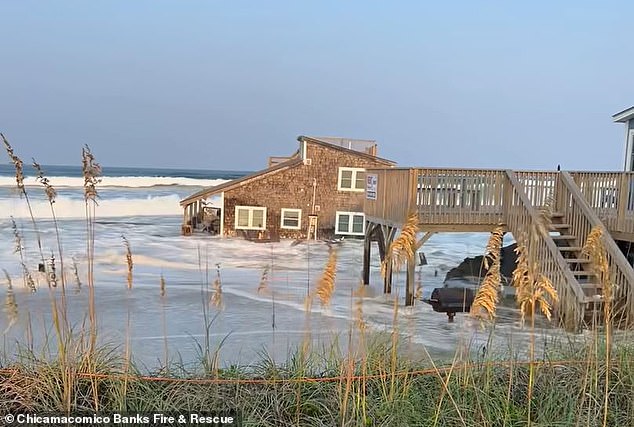Authorities have issued a warning after an unoccupied beachside home collapsed into the ocean on North Carolina’s Outer Banks.
Images of the home in Rodanthe show it collapsing after being hit by storm surge from Hurricane Ernesto on Friday.
The two-storey house can be seen being swept away by the waves before it begins to break apart in the turbulent waters.
Part of the porch can be seen crumbling as the house disintegrates in front of dozens of passersby, who can be heard saying, “Oh my God.”
According to officials, the house was unoccupied at the time and no injuries were reported and they advised locals to stay out of the waters.
The two-storey house can be seen being swept away by the waves before it begins to break apart in the turbulent waters.

Images of the Rodanthe home show how it collapsed after being hit by a wave from Hurricane Ernesto on Friday. Here you can see the debris left behind from the house
Cape Hatteras National Seashore said in a statement: ‘Cape Hatteras National Seashore and Pea Island National Wildlife Refuge strongly urge all visitors to avoid the beaches and stay out of the water around all beach and surf areas in Rodanthe.
‘It appears that many other homes have been damaged in the Rodanthe area. There may be dangerous debris on the beach and in the water for more than twelve miles.
‘The prevailing currents appear to be rapidly transporting household waste northwards; however, if waves increase and winds shift in the coming days, the waste may also affect the safety of visitors to the villages of Waves and Salvo.
‘The Seashore is in contact with the property owner. The owner has not secured a contractor for debris removal at this time.
‘Seashore does not expect significant debris removal efforts to occur until elevated sea conditions subside early next week.’
Aftermath images show the picturesque beaches littered with debris from the house.
According to the National Park Service, this is the seventh home collapse on Seashore beaches in the past four years.
The Chicamacomico Banks Fire and Rescue team warned that “it’s going to be a rough weekend” and strongly advised against anyone entering the ocean.

Images from the aftermath show the picturesque beaches littered with debris from the house.

According to the National Park Service, this is the seventh home collapse on Seashore beaches in the past four years.
In a nearly identical incident, another beachside home collapsed and was swept into the waters in Rodanthe in May.
More than 50 beaches along the East Coast were closed Saturday due in part to dangerous rip currents ahead of Hurricane Ernesto.
The hurricane moved through Bermuda as a Category 1 storm early Saturday and is not expected to make landfall in the United States.
The National Hurricane Center reported life-threatening waves and rip currents on the East Coast and said they would reach Canada during the day and pass near southeastern Newfoundland late Monday.
In New York City, officials closed oceanfront beaches to swimming and walking in Brooklyn and Queens on Saturday and Sunday.
Lifeguards were still on hand, patrolling the beaches and warning people to stay out of the water.
“New Yorkers should know that the ocean is more powerful than you, particularly this weekend,” Mayor Eric Adams said in a statement.
He continued: “Do not risk your life, or the lives of lifeguards, by swimming while our beaches are closed.”
Hurricane specialist Philippe Papin of the National Hurricane Center said Ernesto remains a “fairly large” hurricane with a “large footprint of seas and waves” affecting the Atlantic coast from central Florida to northern Long Island in New York.

This satellite image shows Hurricane Ernesto in the Atlantic Ocean south-southwest of Bermuda on Friday, August 16, 2024.
Papin said: “The entire region along the US East Coast is expected to see rough seas and significant threats of rip currents along the coast.”
The National Oceanic and Atmospheric Administration describes rip currents as “narrow, powerful channels of fast-moving water” that move at speeds of up to 8 feet (2.44 meters) per second.
Forecasters are also warning the public in New England to beware of dangerous rip currents caused by Ernesto.
“Even if Ernesto remains off the U.S. East Coast, beachgoers should be aware of the significant risk of life-threatening rip currents beginning later this week,” the National Hurricane Center said this week.
According to the Department of Health and Human Services, thirty people have died from rip currents this year alone. National Weather Service.


